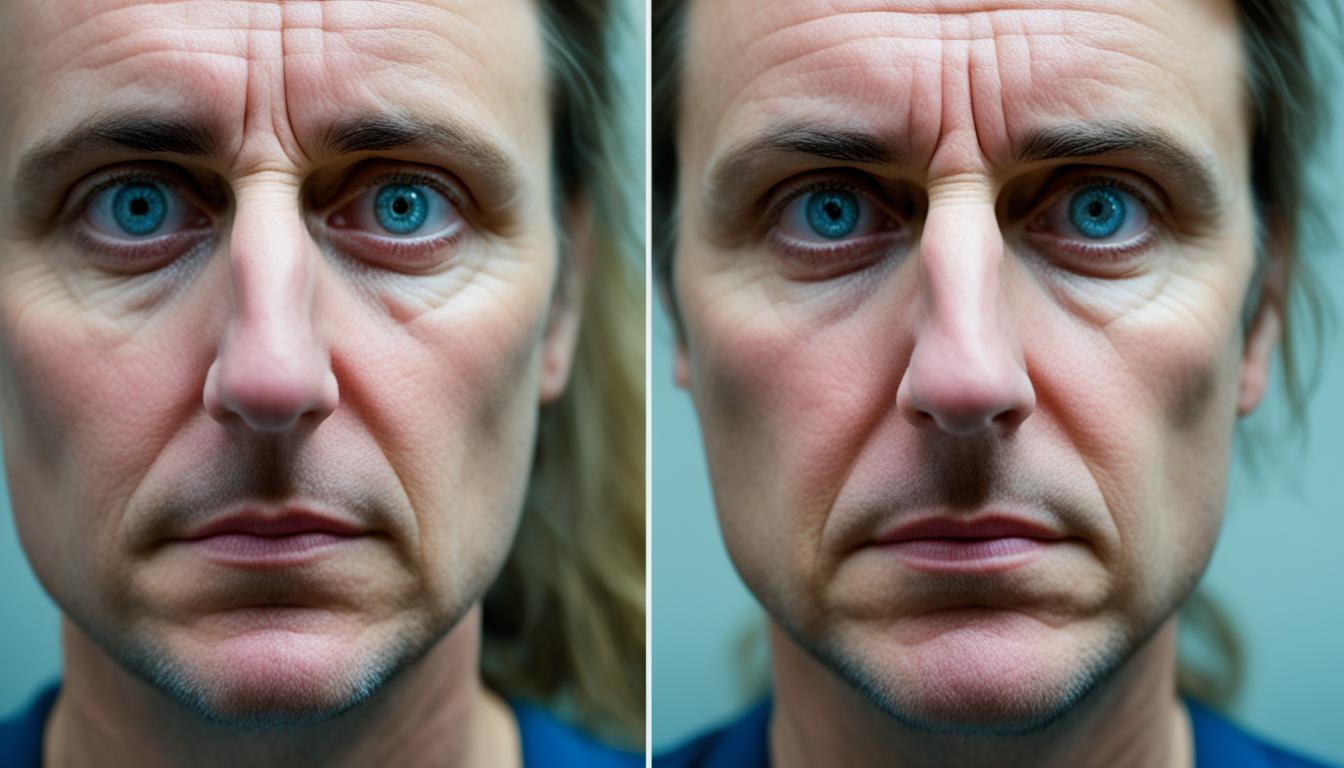Bell’s palsy is a type of facial paralysis. It affects one side of the face, making it hard to move. The cause isn’t always clear, but it’s often linked to problems with the facial nerve. This nerve helps control your face’s muscles.
The condition starts suddenly. Then, it might get worse over a day or two. We don’t always know why it happens. But certain health conditions or infections can raise your risk.
Diagnosing Bell’s palsy means ruling out other possible causes. Finding the cause early is really important for the best treatment. Most people get better within three weeks. But, some might need help if their symptoms last longer.
Doctors are looking into using stem cell therapy to treat Bell’s palsy. This shows promise for the future of treating this condition.
Key Takeaways:
- Palsy Bell’s, also known as acute facial palsy, affects one side of the face with muscle issues.
- Bell’s palsy is linked to the facial nerve and often starts quickly.
- It’s important to find the cause early to treat it well.
- Stem cell therapy could be a new way to treat Bell’s palsy.
Anatomy and Etiology of Bell’s Palsy
Understanding the facial nerve is key to knowing the difference between types of issues. The nerve is divided into motor, sensory, and parasympathetic parts. It moves in segments through the body, reaching from the brain to the face.
This nerve controls parts of the face, like muscles and glands. Because of this, it’s important for facial expressions and other functions.
Bell’s palsy may happen when certain viruses become active again. These are often viruses like herpes zoster and herpes simplex. But, other viruses can also be a factor.
In some cases, issues with blood flow, like in people with diabetes, might cause Bell’s palsy too.
Stem Cell Therapy for Bell’s Palsy
Stem cell therapy is a new hope for fighting Bell’s palsy. This disease causes paralysis of the face. By using cells from the umbilical cord (UC-MSCs), it’s possible to help the body heal. This method is especially good for people who haven’t gotten better with usual treatments.
A special study shows the power of UC-MSCs. In this study, a person had Bell’s palsy for seven years. After receiving eight UC-MSC treatments, this person got completely better. Their symptoms did not come back. This success hints at a new chance for those not helped by other treatments.
More research is needed to fully understand stem cell therapy for Bell’s palsy. Yet, the results of the study are uplifting. They show promise in using UC-MSCs to tackle this condition. This gives hope for the future of treating Bell’s palsy.
FAQ
Q: What is Bell’s palsy?
A: Bell’s palsy is a disorder that affects a nerve in the face, leading to muscle weakness or full paralysis on one side. This condition comes on suddenly and might grow worse within two days. The cause is often unclear, but some factors can make a person more likely to get it.
Q: What are the symptoms of Bell’s palsy?
A: The symptoms of Bell’s palsy are quite noticeable. They include sudden weakness or a loss of movement on one side of the face. Other signs are the drooping of the mouth or eye, trouble fully closing the eye, and changes in taste. People may also feel more sensitive to sounds in one ear and experience pain around the jaw or behind the ear on the affected side.
Q: How is Bell’s palsy diagnosed?
A: To diagnose Bell’s palsy, doctors will rule out other possible causes first. They do this through a detailed physical exam and sometimes imaging tests. Tools like electromyography and nerve excitability tests can show how badly the facial nerve is hurt.
Q: What are the common treatments for Bell’s palsy?
A: The usual treatments for Bell’s palsy aim to ease symptoms and speed up recovery. This may include using corticosteroids to reduce swelling or taking antiviral drugs. Also important is doing physical therapy or facial exercises to rebuild muscle strength and control.
Q: What is the recovery time for Bell’s palsy?
A: Most patients see their symptoms improve and fully recover within three weeks. The recovery period, however, can be different for some. A few might recover partially or completely in a few months. Others may still have some weakness or lingering symptoms after a longer time.
Q: Can stem cell therapy help treat Bell’s palsy?
A: Stem cell therapy, specifically using UC-MSCs, could be a new option for treating Bell’s palsy. These stem cells have qualities that reduce inflammation and support the regrowth of nerve cells. More studies are necessary to confirm its benefits and safety for long-term use. Still, it presents hope for those who haven’t found success with traditional treatments.

